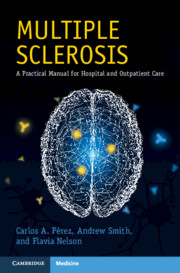Book contents
- Multiple Sclerosis
- Multiple Sclerosis
- Copyright page
- Contents
- Preface
- Chapter 1 Autoimmune CNS Emergencies
- Chapter 2 Clinical Features of Multiple Sclerosis
- Chapter 3 Multiple Sclerosis Phenotypes
- Chapter 4 Diagnostic Evaluation
- Chapter 5 Differential Diagnosis
- Chapter 6 Neuroimaging in Multiple Sclerosis and Its Mimics
- Chapter 7 Disease-Modifying Therapies
- Chapter 8 Treatment Goals
- Chapter 9 Symptomatic Management
- Chapter 10 Reproductive Issues
- Chapter 11 Pediatric Multiple Sclerosis
- Chapter 12 Useful Websites
- Appendices
- Index
- Plate Section (PDF Only)
- References
Chapter 8 - Treatment Goals
Published online by Cambridge University Press: 10 February 2021
- Multiple Sclerosis
- Multiple Sclerosis
- Copyright page
- Contents
- Preface
- Chapter 1 Autoimmune CNS Emergencies
- Chapter 2 Clinical Features of Multiple Sclerosis
- Chapter 3 Multiple Sclerosis Phenotypes
- Chapter 4 Diagnostic Evaluation
- Chapter 5 Differential Diagnosis
- Chapter 6 Neuroimaging in Multiple Sclerosis and Its Mimics
- Chapter 7 Disease-Modifying Therapies
- Chapter 8 Treatment Goals
- Chapter 9 Symptomatic Management
- Chapter 10 Reproductive Issues
- Chapter 11 Pediatric Multiple Sclerosis
- Chapter 12 Useful Websites
- Appendices
- Index
- Plate Section (PDF Only)
- References
Summary
The goals of treatment in multiple sclerosis (MS) have evolved greatly over the past few decades. The original natural history of MS cohorts described in Olmsted County, Minnesota, and in Lyon, France, suggested that MS patients became disabled around the same age regardless of treatment.1,2 Therefore, even after the development of disease-modifying therapies (DMTs), the concept of medical futility remained in the field.
- Type
- Chapter
- Information
- Multiple SclerosisA Practical Manual for Hospital and Outpatient Care, pp. 145 - 156Publisher: Cambridge University PressPrint publication year: 2021

